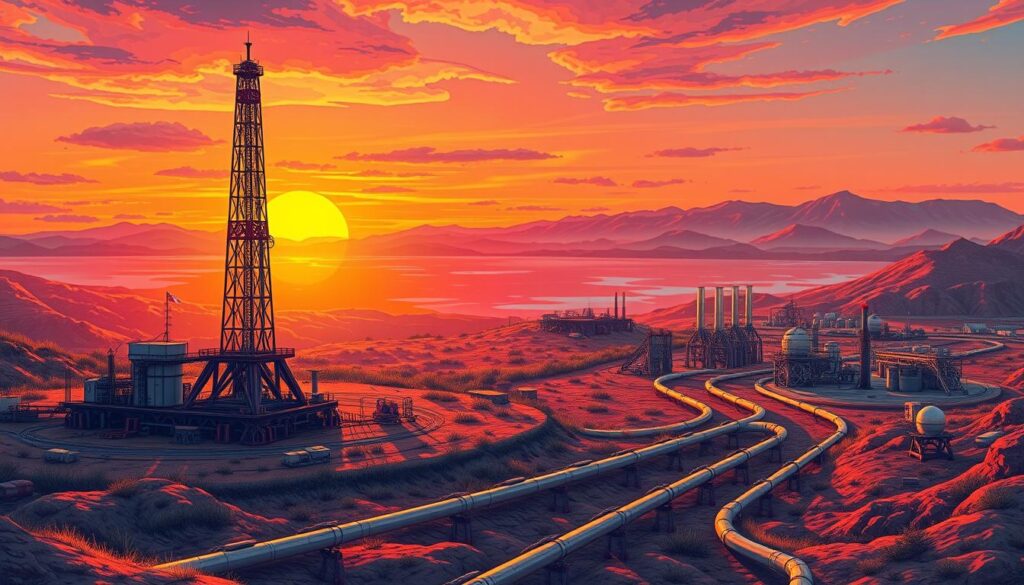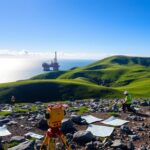What Is Oil Engineering| Did you know oil wells can go as deep as 10,000 feet? This shows how hard it is for petroleum engineers. Oil engineering turns raw earth into vital energy sources.
Oil engineering is a mix of advanced tech and geology. It uses special methods to get and process energy that runs the world.
The oil industry has changed a lot, from the first well in 1848 to today’s tech. Now, we use new ways like multilateral drilling to get more energy.
Learning about oil engineering shows it’s a fast-paced field. It needs science, tech, and solving big problems in energy.
Key Takeaways
- Petroleum engineering involves complex technological processes for extracting oil and gas
- The field requires advanced technical skills and multidisciplinary knowledge
- Oil engineering plays a critical role in global energy production
- Technological innovations continuously reshape extraction methodologies
- Career opportunities in petroleum engineering offer competitive salaries
- Global energy demands drive ongoing advancements in oil engineering
What Is Oil Engineering: Fundamentals and Core Principles
Oil engineering is a complex field that changes how we find, get, and use energy. It mixes science with new tech to find oil and gas underground.
Starting in oil engineering means learning about its main parts: drilling, reservoir, and production engineering. Each is key to getting energy from the ground.
Understanding Petroleum Engineering Disciplines
Drilling engineering is about making safe and good wells. Experts here plan how to drill, pick the right tools, and keep the well strong.
Key Components of Oil Engineering
| Discipline | Primary Focus | Key Skills Required |
|---|---|---|
| Drilling Engineering | Well Construction | Geological Analysis, Technical Design |
| Reservoir Engineering | Resource Optimization | Fluid Dynamics, Pressure Management |
| Production Engineering | Surface Operations | Equipment Management, Flow Control |
Modern Engineering Applications in Oil Industry
Now, oil engineering uses the latest tech like smart sensors, data tools, and automation. These help get energy better, safer, and more precisely.
With a median salary of $137,330 in 2020, oil engineering is both challenging and rewarding financially.
Evolution of Oil Field Technology and Innovation
The oil industry has changed a lot over the years. Oilfield services now help us get and use oil in new ways. We’ve moved from simple drilling to using computers to control operations.
New technologies are key to getting more oil. Hydraulic fracturing and horizontal drilling let us reach oil we couldn’t before. This makes getting oil cheaper and better.
Now, drones help check on oil fields. They do this work faster and safer than before. This cuts down on time and makes things safer.
| Technology | Impact | Efficiency Gain |
|---|---|---|
| AI-Powered Monitoring | Predictive Maintenance | Up to 15% Productivity Improvement |
| Drone Inspections | Remote Monitoring | 30-50% Time Reduction |
| Digital Oilfield Technologies | Real-time Data Analysis | 20-30% Cost Optimization |
Digital changes are big in oilfield services. Using AI, IoT, and analytics makes oil fields smarter. This improves how we get oil, cuts costs, and helps the environment.
The future of oil engineering is all about new ideas. We’re looking at robots for dangerous jobs and using green energy. The goal is to work better, safer, and kinder to our planet.
Types of Oil Rigs and Drilling Systems
Offshore oil rigs are complex and show off advanced engineering. They are a sign of human creativity in getting energy from tough places.
How we design oil wells has changed a lot. New drilling tech lets us get oil from harder places. Modern rigs can work well in many sea conditions.
Land-Based Drilling Operations
Most oil is found on land. These rigs work on different types of ground. They use special ways to drill deeper and get more oil.
They drill by turning the pipe fast. This makes getting oil more efficient.
Offshore Drilling Platforms
Offshore rigs are amazing feats of engineering. They come in different types for different depths and challenges:
| Platform Type | Water Depth Range | Key Characteristics |
|---|---|---|
| Jack-up Rigs | Up to 400 feet | Extensible legs for stability |
| Semi-Submersible Platforms | Up to 12,000 feet | Deep water exploration |
| Tension Leg Platforms | Up to 7,000 feet | Seabed tethered design |
Advanced Drilling Technologies
New tech like electro-drilling and digital twins are changing rigs. They make drilling safer, cut down on harm to the environment, and make oil extraction better. This is thanks to real-time monitoring and smart systems.
Reservoir Engineering and Production Optimization
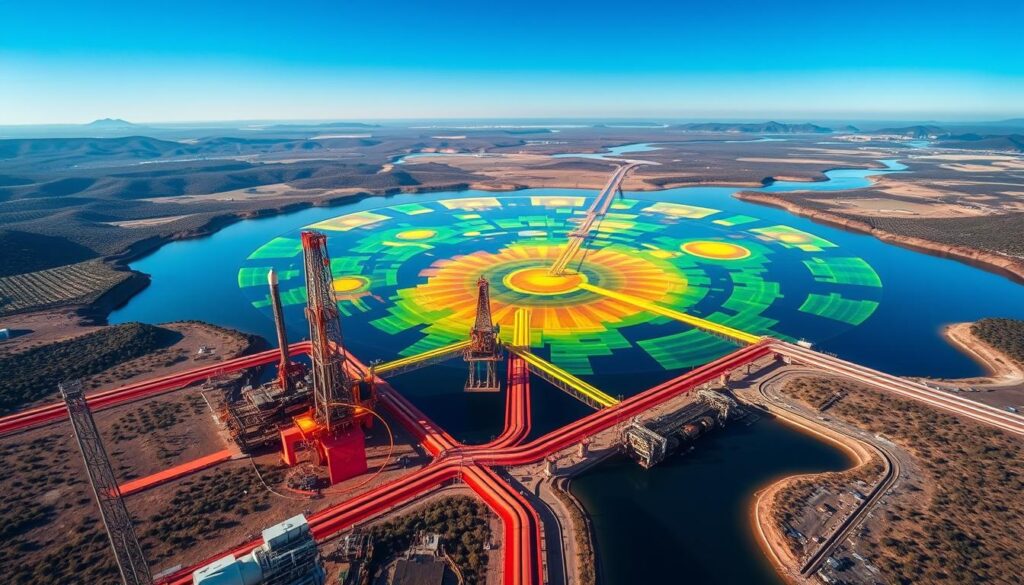
Reservoir engineering is key in oil and gas production. It turns complex underground areas into efficient ways to get hydrocarbons. Advanced tech and smart modeling unlock the full power of underground resources.
Today’s production engineering uses machine learning and AI to change reservoir management. Deep convolutional generative adversarial networks (DCGAN) help predict reservoir pressure. Particle swarm optimization (PSO) also boosts production in tough geology.
Learning about reservoirs gets better with new methods. Smart proxy models cut simulation time from 5 hours to seconds. They’re over 94% accurate, like traditional simulators. These tools help get more oil, up to 30% more.
| Optimization Technique | Performance Improvement |
|---|---|
| Particle Swarm Optimization | 16.2% Incremental Recovery Factor |
| Water-Alternating-Gas Method | 8.2% – 14.2% Net Present Value Increase |
| AI-Driven Modeling | 85% Predictive Accuracy |
Reservoir engineers use digital tools like digital twin technology. This lets them simulate changes in real-time. By mixing geology, advanced math, and tech, they can recover hydrocarbons with great accuracy.
Enhanced Oil Recovery Methods and Techniques
The oil industry is always looking for new ways to get more oil from old wells. Enhanced oil recovery (EOR) is a key strategy for getting more oil than usual.
At first, we can only get about 30% of the oil in a well. But EOR can help get up to 75% of the oil. This can make production go up by 300%.
Chemical and Thermal Recovery Processes
Chemical injection uses special chemicals to help oil flow better. It changes how oil moves in the well. Steam injection is great for heavy oil, making it easier to get.
| EOR Method | Recovery Percentage | Primary Application |
|---|---|---|
| Chemical Injection | 40-60% | Low Permeability Reservoirs |
| Steam Injection | 50-75% | Heavy Oil Fields |
| Gas Injection | 30-50% | Mature Oil Fields |
Gas Injection Technologies
Gas injection is a top choice for EOR. CO2 and nitrogen are the most used gases. Nitrogen is good because it’s safe and cheap to make. CO2 works best in deep wells.
Advanced Recovery Solutions
New tech like fracking and microbial EOR are changing oil getting. Smart water flooding and using tiny particles are new ways to get more oil.
These new EOR methods are making oil getting better and more green.
Safety and Environmental Considerations in Oil Engineering
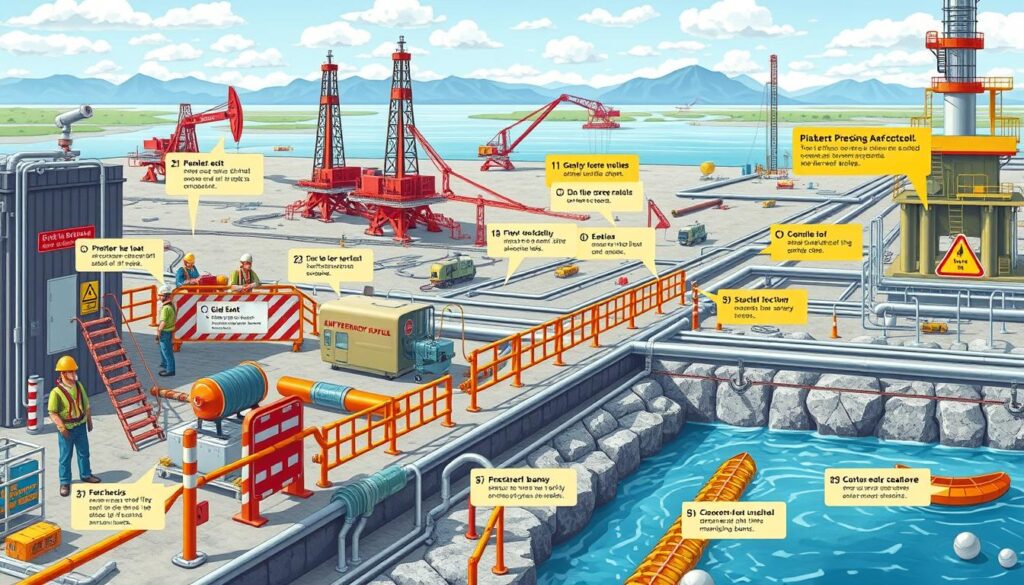
Safety is key in oil well design and oilfield services. The petroleum industry must protect workers and the environment. Sadly, there are many job-related deaths, with about 7.5 fatalities per 100,000 workers.
Keeping workers safe in oil engineering needs strong plans. Using personal protective equipment (PPE) can cut injuries by up to 70%. Companies are now focusing more on safety to avoid dangers.
| Safety Metric | Percentage/Rate |
|---|---|
| Workers Reporting Occupational Health Risks | 30% |
| Safety Incidents Related to Equipment Failure | 75% |
| Reduction in Reportable Accidents | 50% |
Protecting the environment is also very important in oil engineering. Eco-friendly drilling fluids and better waste management help reduce harm to nature. Spill prevention has cut oil spill incidents by 40%.
Following rules is vital for safety. Agencies like OSHA watch over the industry. With new tech and training, safety in oil work is getting better.
Digital Transformation in Oil Engineering
The world of petroleum engineering is changing fast with digital tech. Today, oilfield services use new ways to work, watch, and improve their resources.
Digital change is making big waves in petroleum engineering. McKinsey says 70% of oil and gas companies are just starting to use digital tools. This shows a lot of room for growth.
Automation and Remote Monitoring
Automation is changing oilfield services a lot. It lets teams watch operations from far away. This is thanks to smart sensors and IoT devices that give updates right away.
| Digital Technology | Potential Impact |
|---|---|
| Remote Monitoring Systems | Reduce Operational Risks by 35% |
| Predictive Maintenance | Cut Maintenance Costs by 25% |
| Real-time Data Analytics | Improve Efficiency by 40% |
Artificial Intelligence Applications
Artificial intelligence is changing petroleum engineering a lot. It uses machine learning to help with many things. This includes understanding reservoirs, spotting equipment problems, and finding the best ways to produce oil.
Real-time Data Analytics
Now, engineers can see deeper insights into how wells are doing. This is thanks to IoT sensors and big data. It helps teams make quick, smart choices.
The digital change in oil engineering is more than just tech. It’s about solving big challenges in a tough global energy market.
Conclusion
The world of petroleum engineering is always changing. It’s a mix of new tech, caring for the planet, and solving global energy needs. You’ve learned how the industry has grown, tackling big challenges.
You now see oil engineering in a new light. The industry has changed a lot. Now, 90% of U.S. offshore oil comes from big companies that focus on safety.
The future of petroleum engineering is bright but complex. Engineers will face new rules, green issues, and tech breakthroughs. They must find ways to extract oil better, safely, and with less harm to the environment.
Your knowledge of oil engineering is key to helping the industry grow. The focus on safety, new tech, and caring for the planet will shape our energy future.
